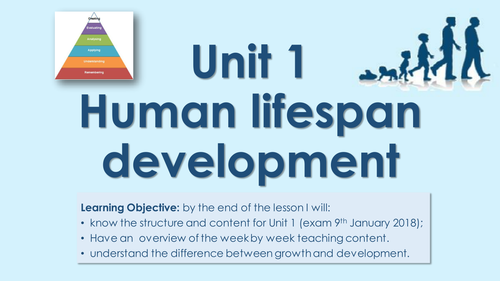
































This is a complete package that has a booklet and week by week programme for Unit one as well as an engaging 18 page booklet covering the A1 part of the spec, which you can add to or alter, getting students to print it off in advance of the lessons.
There are 8 PowerPoints included covering all sections in more detail and having embedded videos and corresponding activities in the booklet to complete either as a classroom activity or a homework task. There are also relevant exam questions from past papers to get them in the swing. This booklet took two whole days to put together so it is guaranteed to save you time and enable you to mould resources to your own teaching style. There is also an mock exam paper for A1 and mark scheme to check progress too.
Content covered
Growth and development are different concepts:
principles of growth – growth is variable across different parts of the body and is measured using height, weight and dimensions
principles of development – development follows an orderly sequence and is the acquisition of skills and abilities.
In infancy (0–2 years), the individual develops gross and fine motor skills:
• the development of gross motor skills
• the development of fine motor skills
• milestones set for the development of the infant – sitting up, standing, cruising, walking.
In early childhood (3–8 years), the individual further develops gross and fine motor skills:
riding a tricycle, running forwards and backwards, walking on a line, hopping on one foot, hops, skips and jumps confidently
turns pages of a book, buttons and unbuttons clothing, writes own name, joins up writing.
In adolescence (9–18 years), the changes surrounding puberty:
• development of primary and secondary sexual characteristics
• the role of hormones in sexual maturity.
In early adulthood (19–45 years), the individual reaches physical maturity:
physical strength peaks, pregnancy and lactation occur
perimenopause – oestrogen levels decrease, causing the ovaries to stop producing an egg each month. The reduction in oestrogen causes physical and emotional symptoms, to include hot flushes, night sweats, mood swings, loss of libido and vaginal dryness.
In middle adulthood (46–65 years), the female enters menopause:
• causes and effects of female menopause and the role of hormones in this o effects of the ageing process in middle adulthood.
In later adulthood (65+ years), there are many effects of ageing:
health and intellectual abilities can deteriorate
For more BTEC Level 1/2 Tech Award and BTEC Level 3 Health and Social Care resources, NCFE T-Level Health, CTEC Level 1 and 2 resources, visit the HSCresources Shop, to access the full range of resource packages, with a handy search facility, to save time.
I hope you enjoy the time you’ve saved!
Something went wrong, please try again later.
Amazingly helpful
Another excellent resource! Thank you.
Great resources - thank you!
Theer are some great resources but I cant get the sheets to print out on A4. What size are they?
Report this resourceto let us know if it violates our terms and conditions.
Our customer service team will review your report and will be in touch.